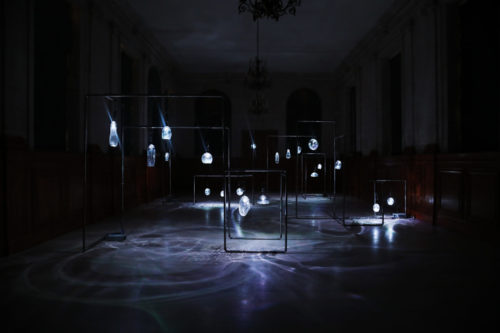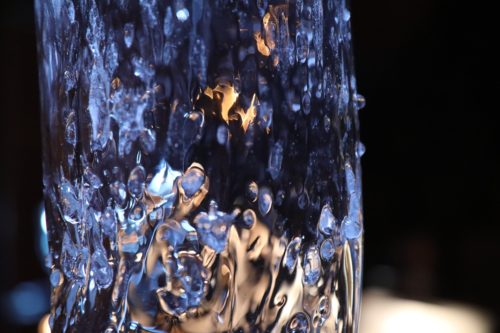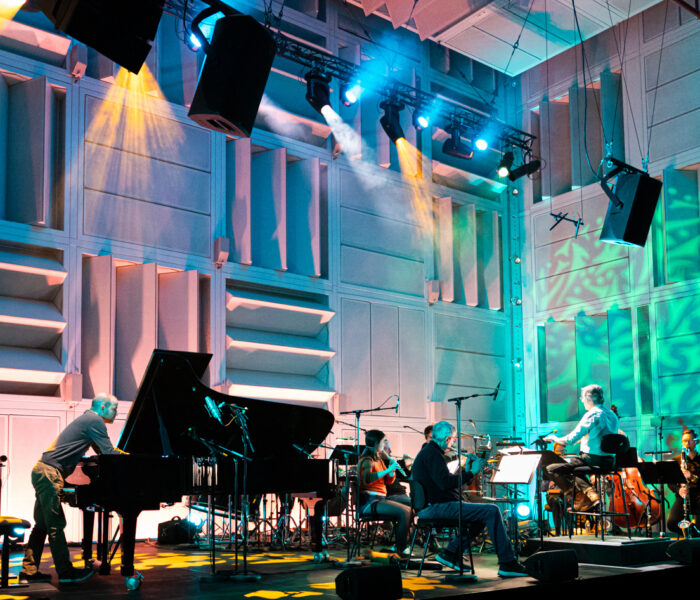La lumière interagit avec le son dans ce « voyage de l’écoute augmenté » imaginé par Laurent Cuniot, directeur de l’ensemble TM+ et l’artiste plasticienne Justine Emard, installant les musiciens au sein de ses structures de verre soufflé dont le spectacle Diffractions en appelle à la synesthésie.
La salle est comble à la Maison de la musique de Nanterre, mêlant un public d’aficionados à un groupe d’écoliers dûment préparé à l’événement par ses enseignants. Six œuvres sont à l’affiche qui vont se succéder dans un flux musical ininterrompu et un déploiement de lumière qui varie d’autant ses couleurs et son intensité. « Supraorganism de Justine Emard est une installation réactive composée d’une vingtaine de sculptures en verre robotisées, animées par une intelligence artificielle élaborée à partir de données collectées dans une communauté d’abeilles », explique sa conceptrice.
L’installation est à l’origine de l’écriture de la pièce d’Helena Tulve, compositrice estonienne et co-directrice du festival Estonian Music Days de Tallinn. En reprenant l’écho des moteurs dans sa composition, Helena Tulve intègre la dimension sonore de l’installation générée par un système d’apprentissage automatique qui s’adapte en temps réel à l’univers de la pièce. En d’autres termes, l’œil écoute dans Emergence II. Sans fond ni rivage. La musique impalpable, d’un grand raffinement de timbres, projette ses images infiltrées par la lumière, dans un espace mouvant traversé d’énergies divergentes : chocs sourds ou résonnants et échos multiples d’un paysage sonore étrange balançant entre bruits de nature et artifices de l’écriture.
En amont de la pièce donnée ce soir en création, s’affichent cinq œuvres filant à leur manière le thème de la nature et ses couleurs avivées par les structures lumineuses de Justine Emard.
Variation sur la couleur bleue : « A la pointe de Pern, on peut voir un grand oiseau au plumage rayé, tacheté de roux-jaunâtre, de gris et de brun, haut sur pattes, pourvu d’un très long bec recourbé en forme de faucille ». Ce sont les mots d’Olivier Messiaen décrivant le courlis cendré, la dernière créature ailée à figurer dans son Catalogue d’oiseaux. En parfait synesthète, Messiaen accompagne chaque oiseau des parfums et couleurs du paysage où il vit : des sensations que nous fait toucher le pianiste Julien Le Pape particulièrement sollicité ce soir. On l’entend, en soliste toujours, dans le Rossignol en amour de Tristan Murail. C’est d’évidence un hommage à son maître Messiaen : « Au mois de mai, dans la haie de chênes verts, en face de la terrasse, un rossignol a élu domicile. Tout le mois jour et nuit, il a chanté. ll était très amoureux », raconte à son tour Murail. Mais là où Messiaen enregistrait et retranscrivait à la main, le disciple fait appel aux logiciels d’analyse spectrale qui vont transposer, dilater, allonger le signal sonore avec tout le confort moderne! Grappes de couleurs, rythmes-oiseau et profondeur des résonances cisèlent ce bijou écrit il y a peu (2019) par notre compositeur. Plus inattendu dans un panel d’œuvres toutes contemporaines, le premier mouvement du Trio de Ravel, radieux chef d’œuvre de la maturité, nous enchante sous les archets de Noëmi Schindler et David Simpson (et les doigts de Julien Le Pape) dont les sons fragiles des harmoniques aiguës vacillent comme une lumière. La sensation est tout autre et le rapport à la matière tout à la fois tactile et ludique dans le Postlude à l’épais de Philippe Leroux dont le travail exploratoire sur la texture maintient l’écoute suspendue au devenir du son.
Considérant les juxtapositions un peu abruptes des différents univers sonores, on se prend à penser que des articulations judicieusement « cousues » aux enchaînements auraient été l’occasion de profiter plus longuement des incidences musicales et lumineuses et d’exercer plus avant nos capacités de synesthète engagées dans chacune des pièces au programme.
Dominante de rouge : le voyage s’achève avec l’Américain et prolifique Lou Harrison qui vise des contrées plus lointaines dans Varied Trio pour violon, percussions et piano dont on entend trois mouvements : Gianny Pizzolato est en vedette, sur son métallophone dans le deuxième mouvement, restituant l’énergie rythmique du gamelan balinais tandis que le piano frappé sous le clavier se mue en tambour de bois.
Autant de sollicitations captées par le robot de Supraorganism pour générer de nouvelles traces lumineuses issues des ombres et reflets projetés par le geste des instrumentistes et le mouvement de la musique. Le spectacle a fasciné l’auditoire comme il a captivé le jeune public, si l’on en juge par la qualité d’écoute maintenue sur toute la durée de la soirée.
Michèle Tosi



)






